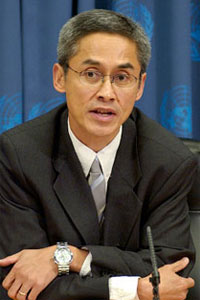
There are currently three key issues pertaining to the marine environment: climate change, loss of biodiversity and pollution. The world's oceans are affected by the degradation of the land, sea and air, which have enormous consequences for the well-being of all living beings, including marine life. The advent of a new international agreement on the protection of the oceans is thus welcome and needs to be followed up effectively.
Last month, the High Seas-related agreement on the conservation and sustainable use of marine biological diversity of areas beyond national jurisdiction ("The Oceans Treaty") was brought into being and it is the first major multilateral oceanic treaty since the 1992 Law of the Sea (LOS) Convention.
Looking back to the 1990s, the LOS offered humanity a platform for respecting different kinds of national jurisdiction concerning sea-borne zones next to the coast. The first zone is known as the Territorial Sea, stretching out to 12 nautical miles from the coastal baseline, with the waters and related seabed and airspace under national sovereignty. Nearby there is the contiguous zone which may not extend beyond 24 miles and it is primarily the zone for immigration purposes.
A key addition due to the LOS was global recognition of the Exclusive Economic Zone (EEZ). The EEZ stretches a maximum of 200 miles from the coast, where the fishing rights and rights over the seabed rest with the coastal state as part of sovereign rights, with the understanding that those sovereign rights are slightly narrower than the notion of sovereignty. Those rights pertain to exploration and exploitation of resources but leave untouched freedom of passage by ships and aircraft of other countries without having to request permission.
The LOS also clarified the older notion of Continental Shelf, which is primarily concerned with the seabed landmass that juts out into the sea from the coast. The LOS stipulated that the jurisdiction of the coastal state over this zone is to be measured not by the depth of the shelf but by the length of the shelf from the adjacent coast. The latter is set at 200 miles from the coast, extendable to the outer edge of the continental margin, which would be configured at a maximum of 350 miles.
Thus, the oceanic area beyond 200 miles was considered at the time of the LOS as the High Seas where generally, all states would enjoy maritime freedoms such as to sail their ships and transport goods uninterrupted and without the need for permission from others.
Yet, the LOS also responded to various concerns in regard to the exploration and exploitation of seabed resources in the High Seas area, in the form of polymetallic nodules, which might be funnelled up for commercial purposes. The LOS agreed that those resources belong to the "common heritage of mankind" to be shared. It classified the oceanic seabed beyond the coastal zones as "the Area", with a global seabed "Authority" to supervise its well-being and equitable commercialisation.
Nevertheless, that Agreement was of limited scope. It was not concerned with protecting the biodiversity of the resources in the High Seas and it did not have specific stipulations on tackling pollution in these areas. After decades of negotiations, the Oceans Treaty now helps to fill in various loopholes.
This new treaty is based on the aim to protect at least 30% of the oceans by 2030 and provides a framework for establishing Marine Protected Areas with safeguards. These areas are defined as "geographically defined marine area that is designated and managed to achieve specific long-term biodiversity conservation objectives and may allow, where appropriate, sustainable use provided it is consistent with the conservation objectives".
Marine genetic resources (such as "marine plant, animal, microbial or other origin containing functional units of heredity of actual or potential value") are to be protected and they cover a broader array of life than the fisheries' dimension of the LOS. The treaty is guided by key precepts such as "the polluter pays principle"; the principle of the "common heritage of humankind" (with wording now adjusted from "mankind"!); the freedom of marine scientific research, together with other freedoms of the High Seas; and the principle of equity with fair sharing of benefits. It also amplifies the precautionary approach, requiring effective action to protect the environment even if related data are still evolving.
Notifications and environmental impact assessments are needed in these areas and the treaty sets up various review bodies, including the clearing house under the Conference of States parties, complemented by the secretariat and periodic Conference of States parties. Equitable sharing of resources, obviously interplaying with benefits for developing countries and access to technology for such purpose, are reviewed by an access and benefit-sharing committee.
The treaty now awaits ratification by 60 countries to bring it into force. The issue is most relevant to Asean, as Indonesia is now the Chair of Asean and it has vast sea-borne areas under its jurisdiction. A regional forward-looking strategy promoted by Asean will be welcome to help identify areas on the High Seas near Asean zones for protection in future.
In the meantime, on marine pollution, there are many other international agreements inviting membership from the group. These include the 1972 Convention on the Prevention of Marine Pollution by Dumping of Wastes and Other Matter, known as the "London Convention", with a later treaty known as the "London Protocol". They prohibit dumping of wastes at sea, subject to some exceptions. They also advocate "the polluter pays principle" and the precautionary approach. Next will be the evolution of a treaty to counter plastic waste, which has enormous impact on marine life.
The normative structure above is only a drop in the bigger ocean of human sensibility and conduct. There is no substitute for the other oceanic ripples anchored in inclusive education, nurturing empathy and behaviour respectful of the total ecosystem.
